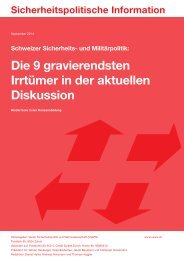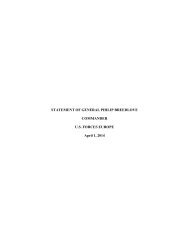FULLTEXT01
FULLTEXT01
FULLTEXT01
You also want an ePaper? Increase the reach of your titles
YUMPU automatically turns print PDFs into web optimized ePapers that Google loves.
TACTICAL THOUGHT<br />
2014 September 29 th<br />
Result and conclusions<br />
The descriptions are of both an explanatory and umbrella character, where the terms<br />
subversion and Insurgency cover all power aspects from nonviolence to divisional<br />
warfare with ground forces. Thompson uses the term “Guerrilla War” and “war of<br />
movement” to separate ambushes from attacks with formations. The potential of<br />
explaining content covers aspects of strategy and, to a degree, operational art and<br />
tactics. Fighting power factors are covered as physical factors but the focus is on<br />
conceptual factors. Moral factors are dealt with. The descriptions cover characteristics<br />
of subversion and insurgencies and also regarding the need to re-design regular military<br />
units for Counterinsurgency operations.<br />
Greater demands on junior officers and capabilities to operate “like guerrillas” are<br />
advocated by Thompson. Attitude aspects are included. Participating actors are<br />
described both from the attacker and defender positions. The description leans primarily<br />
on an administrative/political and civil focus. The military focus of the phenomena is,<br />
however, clearly elaborated on when speaking of such operations. The descriptions do<br />
not demand understanding of sub-terms as Thompson explains them as they occur. The<br />
descriptions are clear and have good potential of being understood easily.<br />
Roger Trinquir<br />
Roger Trinquir, together with David Galula, represents one of the most prominent Cold<br />
War writers of Irregular Warfare, or “Modern warfare” (La Guerra Moderne), the title<br />
of his well-known book, which has seen growing interest since western countries’<br />
renewed concern about Counterinsurgency. 384 Trinquir uses the terms, Subversive<br />
Warfare or Revolutionary Warfare, claiming them to be a new kind of warfare. 385<br />
Characteristics are argued to be “an interlocking system of actions – political, economic,<br />
psychological, military – that aim at the overthrow of the established authority in a<br />
country and its replacement of another regime” 386 .<br />
Trinquir says; “on so vast a field of action, traditional armed forces no longer enjoy<br />
their accustomed decisive role…..combat actions carried out against opposing armed<br />
forces, are of limited importance and are never the total conflict”. 387<br />
Trinquir labels this arguably new kind of war; “Modern War” and states that studies<br />
about subversive warfare have been frequent, but that these studies rarely go beyond the<br />
stage of Guerrilla Warfare, which comes closest to the traditional form. 388 According to<br />
Trinquier, mostly the offensive form of Guerrilla Warfare has been studied.<br />
384 Roger Trinquir, Modern Warfare: A French View on Counterinsurgency (Westport, CT: Preager,<br />
1964, reprinted 2006).<br />
385 Ibid. p. 5.<br />
386 Ibid. p. 5.<br />
387 Ibid. p. 5.<br />
388 Ibid. p. 6.<br />
45





